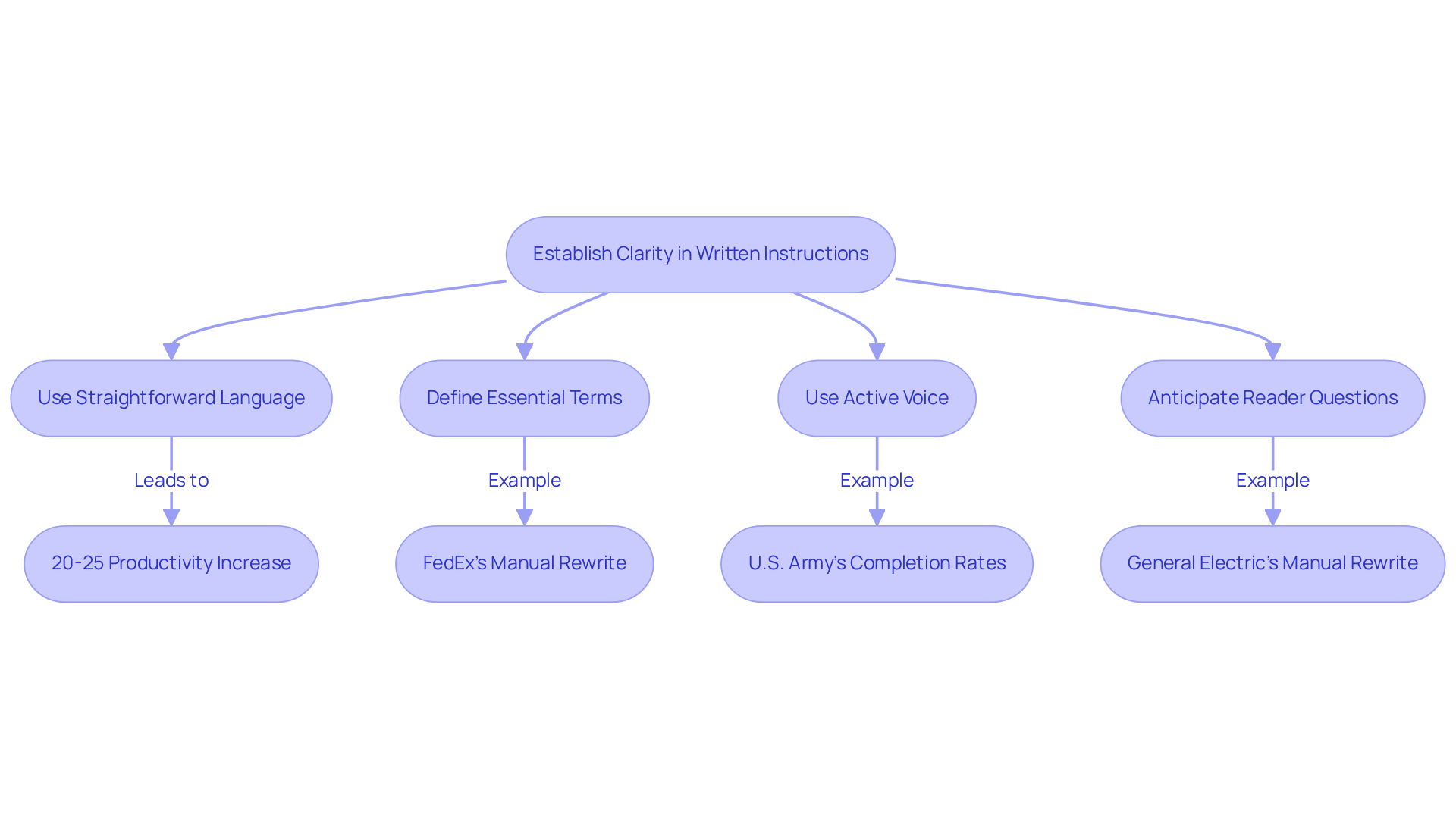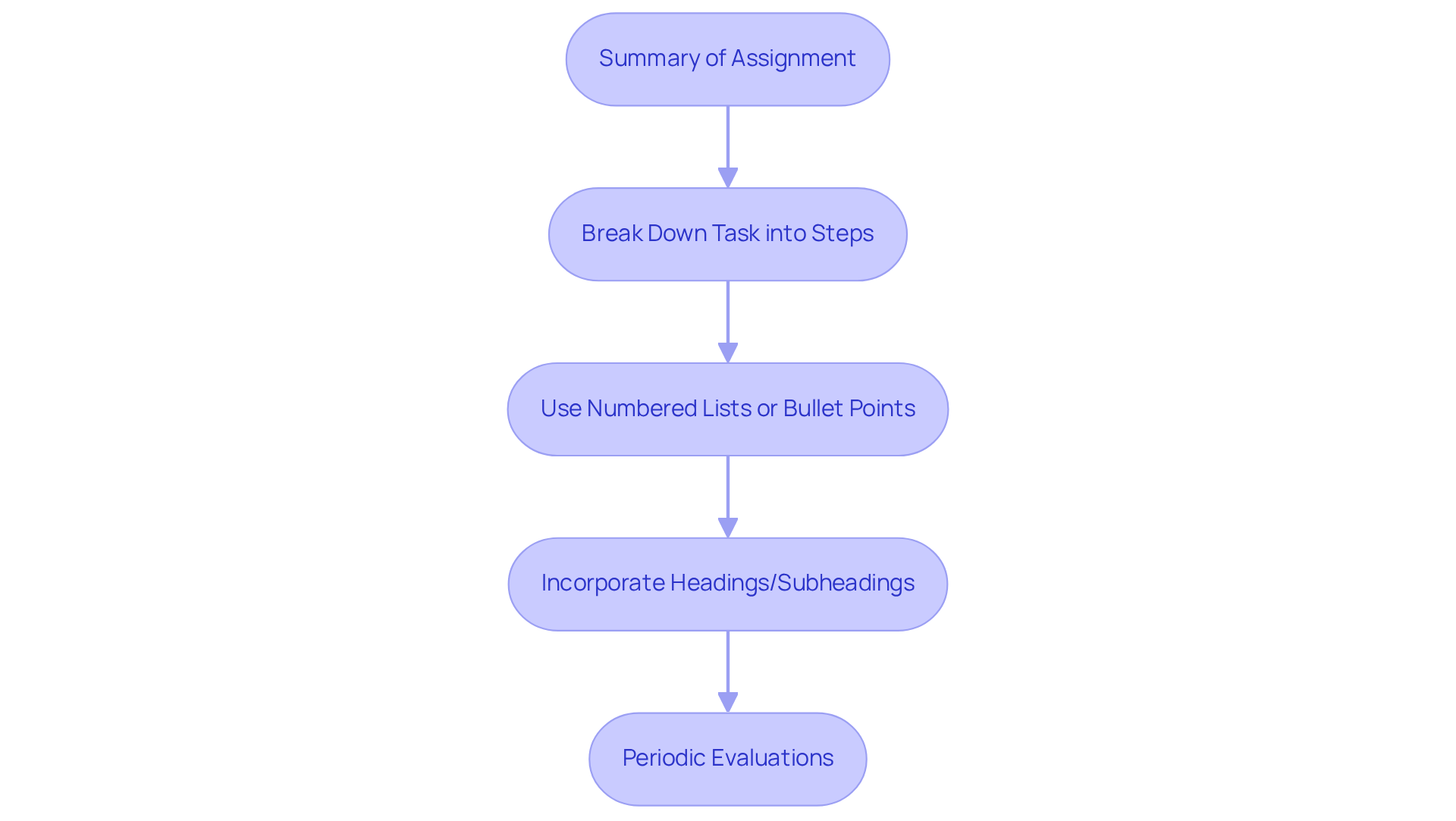
Process Improvement through Documentation
|
October 16, 2025
|
4 Key Practices for Effective Written Instructions
Overview
You might be wondering how to make your written instructions really effective. Well, it turns out that using straightforward language, defining key terms, and employing active voice can make a huge difference. Plus, adding visual aids can really help! Clear communication doesn’t just sound nice; it actually boosts task completion rates and productivity. Research shows that well-crafted instructions can enhance performance by as much as 25%. So, why not give these practices a try and see the impact for yourself?
Key Highlights:
- Use straightforward language to eliminate jargon and enhance clarity in written instructions.
- Define essential terms to ensure all readers understand the content.
- Active voice and direct statements help convey clear actions and set expectations.
- Well-written materials can significantly boost task completion rates and productivity.
- Research shows that clear communication can improve task performance by up to 25%.
- Organise guidelines logically with summaries, sequential steps, and headings for better navigation.
- Concise language increases reader comprehension and engagement, with clear documents being 60% more likely to be fully read.
- Incorporating visual aids like diagrams and flowcharts enhances understanding and makes instructions more engaging.
Introduction
You know, effective communication really is the backbone of any successful operation. Yet, it’s surprising how many organizations struggle with crafting clear written instructions. The ability to convey information succinctly not only boosts comprehension but can also have a big impact on productivity and performance. So, how can businesses make sure their written guidelines are not just understood but also acted upon efficiently? Let’s dive into four key practices that can transform those vague suggestions into clear, actionable directives that truly drive results.
Establish Clarity in Written Instructions
To achieve clarity in your written instructions, it’s important to prioritize straightforward language that eliminates jargon and complex terms. You might be wondering how to start—well, begin by defining any essential terms to make sure everyone’s on the same page. Using active voice and direct statements helps convey actions clearly; for instance, instead of saying 'The report should be submitted by the end of the day,' try 'Submit the report by 5 PM today.' This way, you remove ambiguity and set clear expectations for your readers. Plus, think about your reader’s perspective—anticipate their questions and address them right within the guidelines.
Now, let’s talk about the impact of clear guidance on completion rates. Research shows that well-written materials can really boost task performance. For example, the U.S. Army discovered that recipients of well-crafted letters were twice as likely to complete requested tasks compared to those who received poorly written versions. And it gets better—efficient communication can lead to a 20-25% increase in productivity! That’s a big deal for operations managers. As Joseph Kimble puts it, "Good writing saves hundreds of hours for customer service reps," which highlights just how important effective documentation can be.
Incorporating clear terms not only makes things easier to understand but also enhances your workflow. Take FedEx, for instance; their rewrite of the ground operations manual led to a jump in correct answers from employees, going from 53% to 80%. This change saved the company around $400,000 a year in time spent searching for information. It’s a perfect example of how clear, concise instructions can drive significant operational improvements.
Ultimately, using plain language in your written instructions isn’t just a best practice—it’s a strategic advantage that boosts overall organizational effectiveness. Did you know that poor communication costs U.S. businesses about $2 trillion every year? That really emphasizes the need for clear and effective documentation!

Structure Instructions Logically
To get your guidelines organized in a way that makes sense, you might want to start with a quick summary of the assignment, highlighting those primary goals. Then, break the task down into sequential steps according to the written instructions, ensuring each one builds on the last. Using numbered lists or bullet points can really help present these steps clearly. For example, if you're showing someone how to bake a cake, kick things off by gathering the ingredients, then move on to mixing, baking, and finally cooling. Keeping each step concise and focused on one action helps avoid overwhelming the reader.
Now, think about using headings and subheadings to organize different parts of your guidelines. This makes it easier for users to navigate through the content. Plus, incorporating periodic evaluations of your documentation can keep it accessible and effective, which is a win for user comprehension. By connecting specific guidelines to process descriptions, you're essentially creating practical manuals that include written instructions to ensure tasks are executed efficiently and without errors. Ultimately, a well-organized approach to documentation not only enhances knowledge management but also minimizes the confusion that often comes with vague guidelines. So, let’s dive into making your documentation shine!

Use Concise and Accessible Language
You might be wondering how to develop effective written instructions. Well, it’s all about keeping your wording clear and straightforward! Ditch those filler terms and complicated sentences. For example, instead of saying, 'In order to complete this task, you will need to gather the necessary materials,' just say, 'Gather the necessary materials.'
Using familiar words makes it easier for everyone to understand. Plus, when you use active voice, your sentences become more direct and engaging. Think about it: 'Turn off the machine' is way clearer than 'The machine should be turned off.'
This approach not only saves time but also boosts the reader's ability to grasp your guidance. In fact, documents written in clear terms are 60% more likely to be read fully! And guess what? Using plain language can increase comprehension rates by up to 50%.
So, by focusing on being concise and clear, you can make sure your guidance is both effective and easy to understand.

Incorporate Visual Aids for Better Understanding
You might be wondering how to make your guidance even more effective. Well, one great way is by incorporating visual aids! Start by identifying key steps in your instructions that could really shine with some visual representation. Think about using diagrams, flowcharts, or images to illustrate these steps. For example, if you’re guiding someone on how to put together furniture, how about including labeled diagrams that show how each component connects? This can really help clarify things!
And don’t forget—your visuals should be clear and directly related to the text. You could even spice things up with color coding or highlighting to draw attention to critical information. This not only enhances understanding but also makes your instructions more visually appealing. Trust me, it encourages users to really engage with the content and makes the whole process a lot more enjoyable!

Conclusion
You might be wondering why establishing effective written instructions is such a big deal. Well, it’s not just a task; it’s a strategic move that can really boost communication and operational efficiency. By focusing on clarity, logical structure, concise language, and even adding some visual aids, organizations can seriously enhance how instructions are conveyed and understood. This approach turns complex information into actionable guidance, making it easier for everyone involved to grasp and tackle their tasks.
Let’s talk about four key practices that can help:
- Establishing clarity through straightforward language
- Structuring instructions logically
- Using concise and accessible language
- Incorporating visual aids
Each of these practices plays a vital role in creating a smoother workflow and improving completion rates. For example, clear instructions can double task completion rates, and concise language boosts comprehension significantly. Plus, visual aids not only enhance understanding but also make following instructions a lot more engaging and enjoyable.
So, why is all this important? The significance of clear and effective written instructions really can’t be overstated. By adopting these best practices, organizations can avoid the costly pitfalls of poor communication and empower their teams to operate at their best. Emphasizing clarity and accessibility in documentation isn’t just a nice-to-have; it’s essential for building a culture of understanding and productivity. Why not implement these strategies today? Unlock the full potential of your written communications and drive your organization toward success!
Frequently Asked Questions
Why is clarity important in written instructions?
Clarity in written instructions is essential because it eliminates jargon and complex terms, ensuring that everyone understands the message. This helps set clear expectations and improves task performance.
How can I start writing clear instructions?
Begin by defining any essential terms to ensure everyone is on the same page. Use straightforward language, active voice, and direct statements to convey actions clearly.
What is an example of clear instruction?
Instead of saying, 'The report should be submitted by the end of the day,' a clearer instruction would be, 'Submit the report by 5 PM today.'
How does clear guidance affect completion rates?
Research shows that well-written materials can significantly boost task performance. For example, the U.S. Army found that recipients of well-crafted letters were twice as likely to complete tasks compared to those who received poorly written versions.
What impact does effective communication have on productivity?
Efficient communication can lead to a 20-25% increase in productivity, which is particularly beneficial for operations managers.
Can you provide an example of a company that improved performance through clear instructions?
FedEx improved its ground operations manual, resulting in correct answers from employees increasing from 53% to 80%, which saved the company around $400,000 a year in time spent searching for information.
What are the broader implications of using plain language in written instructions?
Using plain language is not just a best practice; it is a strategic advantage that enhances overall organizational effectiveness and can help reduce the costs associated with poor communication, which amounts to about $2 trillion for U.S. businesses annually.
👍
What others are liking
5 Steps to outline your ideal documentation structure
5 MINS READ
Where to start the your journey of mapping out your ideal documentation structure, aligning it with the very heartbeat of your organization?
Defining a winning level of detail in your process
3 MINS READ
What is too much detail, and what is too little? This article described in that winning level detail about what detail is enough.





